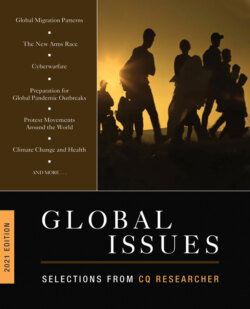Читать книгу Global Issues 2021 Edition - Группа авторов - Страница 54
Background Foundations Laid Early
ОглавлениеVaccines can be traced to 10th-century China, when the first precursor of today’s immunizations was used to guard against smallpox.21
In 1796, English country doctor Edward Jenner inoculated an 8-year-old boy with pus from a cowpox lesion on a milkmaid’s hand. Six weeks later, when Jenner infected the boy with smallpox, the disease failed to take hold, laying the foundation for modern vaccinology.
A painting by Georges Gaston Mélingue shows the first vaccination, performed by English doctor Edward Jenner, who is inoculating 8-year-old James Phipps in 1796 using pus from a cowpox lesion on a milkmaid’s hand.
Christophel Fine Art/Universal Images Group via Getty Images
The 20th century ushered in the modern age of immunology with vaccines against pertussis, also called whooping cough, in 1914, diphtheria in 1926 and tetanus in 1938. By the late 1940s, vaccines were being mass-produced, allowing the implementation of disease control policies on a much broader scale.
Following a record-setting polio outbreak of almost 58,000 cases in 1952, medical researcher Jonas Salk announced he had developed a vaccination for the dreaded disease, which frequently caused paralysis and was often fatal. The polio vaccine was introduced in 1955, followed by the measles vaccine in 1963. Vaccines against mumps and rubella followed in 1967 and 1969, respectively. All three were combined into the MMR vaccine in 1971.
Every February the CDC updates its recommendations on who should receive vaccines, at what age, how many doses, the length of time between doses and what combination, if any, of vaccines should be given. While the CDC’s recommendations are not mandatory, states typically use the CDC schedule as the basis for requiring children to be vaccinated before they can attend public schools. All 50 states and the District of Columbia require public school students to be vaccinated, while allowing exemptions for medical reasons. Forty-four states and the district allow exemptions based on religious grounds and 15 states allow exemptions for personal, moral or other beliefs. Five states—New York, California, Maine, Mississippi and West Virginia—do not allow religious or philosophical exceptions.22
